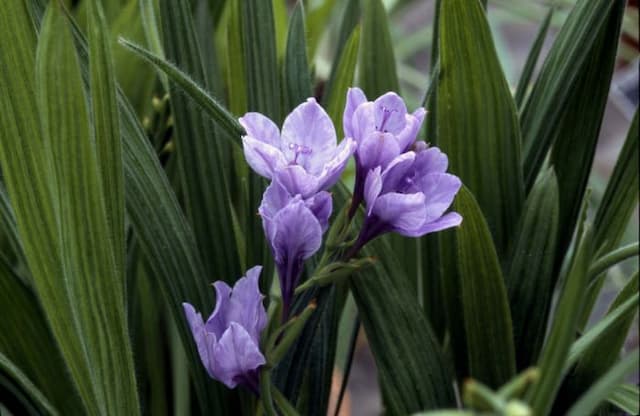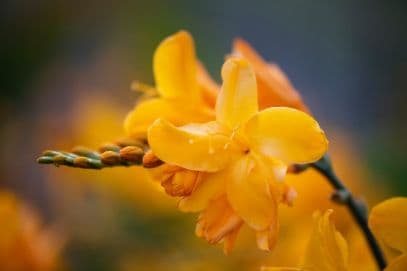Tall Bearded Iris Iris 'Kiss of Summer' (TB)

ABOUT
Iris 'Kiss of Summer' is known for its captivating beauty that exudes the essence of the warmer months. This variety showcases distinctive flowers that boast a combination of colors. The petals can display a gorgeous gradient that starts with a buttery yellow at the bases, elegantly transitioning to a creamy white towards their tips. These hues may be complemented by delicate veins or flecks of a soft violet or a gentle lilac, adding depth and intrigue to the overall appearance of the bloom. The flowers typically have three upright petals, known as standards, and three downward-curving petals called falls, which is characteristic of irises. In the middle of the falls, a fuzzy area called the beard is prominently featured, and it can be a contrasting or coordinating color that adds to the visual interest of the flower. The foliage of Iris 'Kiss of Summer' consists of long, slender leaves that grow upright, forming a fan-like structure. The leaves are a deep, rich green and have a slightly sword-like shape, adding to the vertical element of the plant's profile and providing a lush backdrop for the stunning flowers. Iris 'Kiss of Summer' blooms during the iris flowering season, which can vary but often falls between late spring and early summer. When in bloom, the flowers are particularly striking and can serve as a focal point in a garden design. The overall charm of this iris cultivar lies in its striking blooms which are both elegant and playful, echoing the warm and joyful feeling of summer with every petal.
About this plant
 Names
NamesFamily
Iridaceae
Synonyms
Tall Bearded Iris, Bearded Iris
Common names
Iris 'Kiss of Summer' (TB)
 Toxicity
ToxicityTo humans
Tall Bearded Iris, including 'Kiss of Summer', are not considered highly toxic to humans; however, they can potentially cause mild stomach upset if ingested. Handling the plant, especially the rhizomes, may sometimes cause skin irritation due to the presence of irisin, iridin, or other compounds. It is advisable to take caution and not consume any parts of this plant.
To pets
Tall Bearded Iris can be toxic to pets, particularly if they consume the rhizomes. Ingesting parts of the Iris can cause symptoms such as vomiting, diarrhea, drooling, and lethargy. In some cases, more severe gastrointestinal upset can occur. It is important to keep these plants out of reach of pets to prevent any accidental ingestion.
 Characteristics
CharacteristicsLife cycle
Perennials
Foliage type
Deciduous
Color of leaves
Green
Flower color
Mixed
Height
3 feet (91 cm)
Spread
1 foot (30 cm)
Plant type
Bulb
Hardiness zones
Varies
Native area
Varies
Benefits
 General Benefits
General Benefits- Ornamental Appeal: Iris 'Kiss of Summer' features beautiful flowers that enhance the aesthetic of gardens and landscapes.
- Drought Tolerance: Once established, it typically requires less water compared to non-drought-tolerant plants, making it suitable for xeriscaping.
- Low Maintenance: This iris variety generally requires minimal upkeep aside from occasional deadheading and division every few years.
- Long Bloom Season: 'Kiss of Summer' has a relatively long flowering season, providing color and interest for an extended period in spring and summer.
- Attracts Pollinators: The blooms attract bees, butterflies, and other beneficial pollinators, supporting local ecosystems.
- Ideal for Cut Flowers: The long stems and striking blooms make 'Kiss of Summer' a good choice for use in floral arrangements.
- Versatile Planting Options: It can be successfully planted in borders, beds, and as part of mixed perennial plantings.
- Hardiness: 'Kiss of Summer' is a hardy variety that can withstand cold winter temperatures in many regions.
 Medical Properties
Medical PropertiesThis plant is not used for medical purposes.
 Air-purifying Qualities
Air-purifying QualitiesThis plant is not specifically known for air purifying qualities.
 Other Uses
Other Uses- Artistic Inspiration: The unique coloration and form of the iris can inspire artists in their work, becoming a subject for paintings, photographs, and textile designs.
- Fragrance Extraction: The scent of the iris might be used in the production of perfumes and scented oils.
- Gift Plant: Potted irises can be offered as living gifts for special occasions, symbolizing hope, wisdom, and compliments.
- Water Garden Highlight: This iris may be planted around water gardens as it can tolerate moist conditions and enhance the aesthetic with its upright foliage.
- Garden Borders: The iris can be used to create stunning borders due to its height and vibrant bloom, defining garden paths and spaces.
- Photography Subject: The plant can be a striking subject for nature photographers, especially when capturing the nuances of light and shadow during the 'golden hours' of sunrise and sunset.
- Dried Flower Arrangements: The blooms and seed pods of the iris can be dried and included in long-lasting floral displays or craft projects.
- Educational Tool: The diverse morphology of the iris can be used to teach botany and horticulture, demonstrating plant structure and pollinator attraction strategies.
- Fauna Support: Planting irises in the garden can provide shelter and potential food sources for local fauna, including birds and beneficial insects.
- Cultural Events: In regions where irises hold cultural significance, the 'Kiss of Summer' may be featured in festivals or parades associated with spring and floral beauty.
Interesting Facts
 Feng Shui
Feng ShuiThe Iris is not used in Feng Shui practice.
 Zodiac Sign Compitability
Zodiac Sign CompitabilityThe Iris is not used in astrology practice.
 Plant Symbolism
Plant Symbolism- Hope: The iris often symbolizes hope, reflecting a belief that positive outcomes are on the horizon.
- Faith: Many associate irises with faith, as their natural beauty can evoke a spiritual sense of belief and trust.
- Courage: Due to their bold colors and upright stance, irises can represent courage and admiration.
- Wisdom: In some cultural contexts, irises are symbolic of wisdom and valued for their graceful appearance.
- Royalty: Historically, the iris has been tied to royalty and nobility, especially because of its association with the French monarchy's fleur-de-lis.
 Water
WaterTall Bearded Iris should be watered deeply once a week during their active growth period, especially if the weather is dry. Provide about one gallon of water per plant each time to ensure moisture reaches the root zone. During periods of intense heat or drought, increase the frequency to twice a week but be cautious not to overwater, as Iris rhizomes are prone to rot with excessive moisture. During the winter dormancy period, reduce watering significantly, only providing supplemental water if there are extended periods without rainfall.
 Light
LightTall Bearded Iris thrives in full sunlight, needing at least 6 hours of direct sun daily for best growth and flowering. Select a spot in the garden that receives ample sunshine throughout the day. These Irises can tolerate partial shade, but they may not bloom as prolifically.
 Temperature
TemperatureTall Bearded Iris prefers temperate climates with temperatures typically ranging from 65°F to 86°F. They can tolerate winter temperatures down to about 14°F, but they should not be exposed to prolonged freezing conditions. Ideal growing conditions include warm, sunny days and cooler night temperatures, which help to promote healthy growth and vibrant blooms.
 Pruning
PruningPrune Tall Bearded Iris by removing spent flower stalks to the base of the plant to encourage a tidy appearance and prevent seed formation. After blooming, cut back the entire foliage by about a third to promote good air circulation. The best time for a thorough cleanup is in late summer to early fall when you can also divide overcrowded clumps.
 Cleaning
CleaningAs needed
 Soil
SoilTall Bearded Irises, such as 'Kiss of Summer,' thrive in a well-draining soil mix composed of loamy or sandy soil, with some compost or aged manure mixed in to provide nutrients. The soil should have a slightly acidic to neutral pH, ideally between 6.5 and 7.0, to support optimal growth.
 Repotting
RepottingTall Bearded Irises like 'Kiss of Summer' generally do not need frequent repotting; however, they should be divided and replanted about every 3 to 4 years to prevent overcrowding and maintain plant vigor.
 Humidity & Misting
Humidity & Misting'Kiss of Summer' Tall Bearded Irises prefer moderate ambient humidity levels but are quite adaptable and can tolerate the drier conditions typically found in temperate climates.
 Suitable locations
Suitable locationsIndoor
Ensure bright light, cool temperatures, and good airflow for indoor Irises.
Outdoor
Plant in well-drained soil with full sun to part shade exposure.
Hardiness zone
3-9 USDA
 Life cycle
Life cycleThe life cycle of the Tall Bearded Iris 'Kiss of Summer' begins with seed germination, which takes place in a well-drained soil bed with exposure to partial to full sun. Following germination, the seedling grows into a juvenile plant with characteristic long, narrow leaves. The Iris then reaches a vegetative stage where the plant focuses on root and foliage growth, eventually forming the distinct rhizomes that store nutrients. Once mature, the Iris enters the flowering stage, typically in late spring to early summer, producing its distinctive large and colorful blooms. After pollination, seeds are formed in the spent flowers, which can be harvested for propagation or left to fall and potentially give rise to new plants. The plant then goes into a period of dormancy, with foliage dying back in the fall before regenerative growth resumes in the following spring.
 Propogation
PropogationPropogation time
Late summer-early fall
The most popular method of propagating the Tall Bearded Iris 'Kiss of Summer' is by division, which is typically done after the blooming period in late summer to early fall. The process involves digging up the clump of irises and gently separating the rhizomes, which are the thick, fleshy roots, ensuring each division has at least one fan of leaves and a portion of the rhizome. Trim the leaves to about a third of their height to reduce water loss and replant the divisions at soil level, spacing them about 12 to 24 inches apart (approximately 30 to 61 cm) to allow for ample growing space. The divided rhizomes should be planted in well-draining soil with the top of the rhizome exposed to the sunlight. This method rejuvenates the plant by reducing overcrowding, also giving an opportunity to check for and remove any diseased or damaged parts of the plant.









